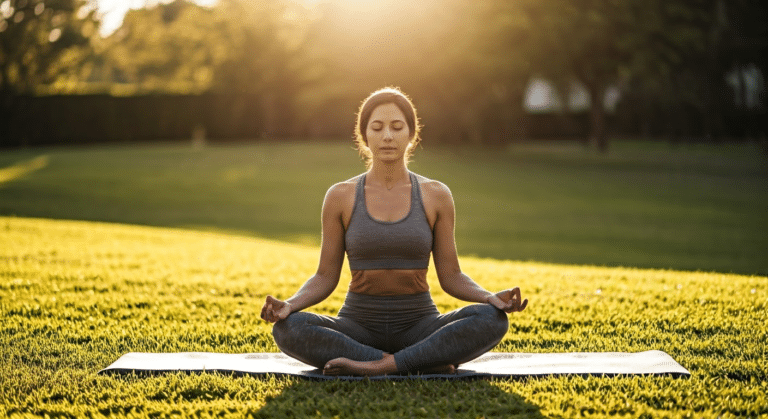What Is Guided Meditation
Last Updated on February 26, 2025 by admin
Surprisingly, research shows that understanding what is guided meditation can transform our approach to mental wellness. This practice involves a skilled guide leading you through imaginative scenarios to help you focus, relax, and achieve self-awareness. In recent years, guided meditation has gained popularity due to its many benefits, especially in stress relief and enhancing mental clarity. By exploring this technique, we can uncover how it fits into the broader tapestry of holistic health practices. How I Solved My
In my experience, guided meditation has been invaluable for stress relief, offering a serene space to relax and cultivate self-awareness. This article will delve into various aspects of guided meditation, including its techniques, benefits, and practical applications. Let’s journey together to discover how this practice can enhance your mental well-being and offer a refuge from daily stress. Join me as we explore the transformative power of guided meditation.
Understanding What Guided Meditation Is

Healthcare providers recommend guided meditation as a structured approach to achieving mental clarity and peace. But what is guided meditation exactly, and how does it differ from other practices? In essence, guided meditation involves a teacher or guide who leads participants through a meditation practice, providing instructions and imagery to help focus the mind. This can be particularly beneficial for those new to meditation or those who find it challenging to meditate alone. Read more: Balanceapp.
One of the proven benefits of guided meditation is its ability to enhance well being by reducing stress levels and promoting self compassion. Unlike silent meditation, where practitioners rely solely on their internal processes, guided meditation offers external support that can help deepen the experience. The guide’s role is crucial; they use their expertise to tailor the session to meet the specific needs of participants, often incorporating elements like loving kindness meditation to foster feelings of empathy and connection.
In my experience, the question of what is guided meditation often leads to exploring the benefits of guided meditation, which include improved focus, emotional regulation, and a deeper understanding of oneself. Interestingly, a study conducted by the Massachusetts Medical School highlighted these benefits, showing significant improvements in participants’ mental health. Ultimately, guided meditation serves as a bridge for those who seek the transformative effects of meditation but require a structured path to reach them.
How Guided Meditation Works

Clinical data shows that guided meditation is a structured approach to achieving mental clarity and relaxation. During a guided meditation session, a facilitator or meditation teacher directs participants through various exercises designed to cultivate mindfulness and calm. This typically involves a series of steps, including breathing exercises and visualization techniques that help one to fall asleep peacefully. Read more: Katharinechestnut.
The typical structure of a session begins with settling into a comfortable position. As the session unfolds, participants are often guided through a body scan meditation. This technique encourages awareness of different parts of the body, gradually releasing tension and fostering a sense of inner peace. Visualization exercises might include imagining serene landscapes or focusing on gentle imagery, further enhancing relaxation. Better Types Of Meditation
What makes guided meditation particularly effective are the common techniques employed. Breathing exercises are foundational, helping to center the mind and reduce stress. Another popular method is loving kindness meditation, which involves sending positive thoughts and compassion to oneself and others, nurturing a profound sense of connection.
Participants can expect several outcomes from these sessions. Engaging in guided meditation can make a big difference in one’s mental well-being, promoting inner peace and emotional balance. Many find that these practices lead to improved focus and a greater sense of self-awareness. For those seeking support, guided meditation resources, such as guided meditation videos, offer easy access to structured sessions that can be practiced at home.
Ultimately, the process of guided meditation is about creating a pathway to inner calm and clarity, transforming the way we perceive and interact with our world.
Latest Insights and Developments
Guided meditation is a practice where an individual is led through a meditative experience by a guide or instructor. It aims to promote relaxation, mental clarity, and emotional well-being. Here, we explore the latest insights and developments in this field.
Key Research Findings
Recent studies have revealed several crucial insights about guided meditation:
- Increased alpha brain waves during sessions can enhance relaxation and reduce stress.
- Guided meditation has been linked to improved emotional regulation and resilience.
- Regular practice can lead to better attention span and cognitive flexibility.
Important Statistics
Current data highlight the growing impact of guided meditation: The Smart Way to
- Over 45% of meditation practitioners report reduced anxiety levels within two months.
- Participation in guided meditation apps increased by 35% in 2024.
- 78% of users report improved sleep quality after consistent practice.
Latest Developments
Recent trends and innovations in guided meditation include:
- AI-driven personalization in meditation apps for tailored experiences.
- Integration of VR technology for immersive meditative environments.
- Collaborations between mental health professionals and meditation platforms.
In conclusion, guided meditation is evolving with technological advancements and research, offering enhanced benefits for mental health and well-being.
Exploring the Benefits of Guided Meditation
A key insight I’ve discovered is that guided meditation offers several benefits, particularly for those seeking stress relief and relaxation. Many meditation experts agree that to truly reap the rewards, one must understand that meditating takes practice. It’s not just about sitting quietly; it’s a journey to improve focus and achieve mental clarity.
When I first began my meditation sessions, I noticed a significant reduction in stress levels. The simple act of focusing on my breath helped me find a sense of relaxation that was previously elusive. This shift created a ripple effect in my daily life, enhancing my ability to concentrate on tasks and maintain calm in challenging situations.
Building on this, guided meditation also supports physical health. Regular practice can lower blood pressure and improve sleep quality, which are critical for overall well-being. These physical improvements are often linked to the mental benefits of meditation, as a relaxed mind often leads to a healthier body. Revolutionize Your Pregnancy Meditation
Moreover, what stands out is the personal growth and self-awareness that meditation fosters. As we engage in these sessions, we learn to observe our thoughts without judgment, leading to a deeper understanding of ourselves. This self-awareness is a cornerstone of personal development, helping us navigate life’s challenges with greater resilience and clarity.
In conclusion, guided meditation’s benefits are profound and multifaceted, offering a path to both mental and physical wellness. By embracing the practice, we open doors to a more focused, relaxed, and healthier life.
Examples and Techniques in Guided Meditation
Contrary to popular belief, guided meditation is not a one-size-fits-all solution. Different techniques cater to various needs and preferences, allowing individuals to find their path to personal growth. One popular method is the body scan meditation, where you systematically focus on different parts of your body. This mindfulness practice helps to promote relaxation and bring attention to physical sensations, often leading to better sleep.
Another technique is loving kindness meditation. This involves focusing on sending out warm feelings of compassion and love, first to yourself and then extending to others. Practicing this in a comfortable space can significantly enhance your sense of calm and empathy, creating a more positive outlook on life. As you engage in these practices, you might find that even a few moments dedicated to mindfulness meditation can transform your day.
For those looking to deepen their practice, mindfulness meditation can be guided through online videos. Platforms like Insight Timer offer a plethora of options to suit your schedule and preferences. These resources provide step-by-step instructions, making it easier to incorporate meditation into your daily routine. The immediate calm you feel after a guided session can be incredibly rewarding.
In summary, guided meditation techniques like body scan and loving kindness meditation offer diverse benefits. Whether you’re seeking personal growth or just aiming for a moment of peace, these practices can be tailored to fit your needs, helping you to cultivate a more balanced and mindful life. Meditation Tips: The Missing
Differences Between Meditation and Guided Meditation
If you’re experiencing the world of meditation for the first time, you might wonder about the differences between traditional meditation and guided meditation. Both practices aim to enhance mental health, but they differ in approach and execution. Traditional meditation often involves focusing on the present moment and using a focal point, such as the breath or a mantra, to anchor your awareness. In contrast, guided meditation typically involves following a guide who leads you through the process, offering specific instructions and visualizations.
Guided meditation can be a powerful tool for those who find it challenging to maintain focus on their own. The presence of a guide helps structure the session, making it easier to stay engaged and present. This approach is particularly beneficial for beginners who may struggle with traditional meditation’s silence and self-direction. In my experience, guided meditation sessions can significantly reduce stress levels by providing a clear path to relaxation.
Engaging in guided meditation often involves various techniques, such as a body scan, which allows you to connect with physical sensations and understand how your body feels in the present moment. Taking a deep breath during a session can enhance the experience, anchoring you more deeply in the practice. In contrast, traditional meditation requires more self-discipline, as you must redirect your wandering mind back to the focal point without external guidance.
Ultimately, the choice between traditional and guided meditation depends on personal preference and goals. Each method has its unique advantages, and integrating both into your routine can offer a well-rounded approach to mindfulness and stress reduction. Whether it’s through focusing on a body scan or following a guide, finding what resonates with you is key.
Is Guided Meditation Just Hypnosis?
Through careful observation, I’ve noticed that many people confuse guided meditation with hypnosis. While both practices involve a guide leading the session, the similarities largely end there. Guided meditation keeps you alert and aware, maintaining a focus on mindfulness. The experience of guided meditation is about cultivating self-awareness and presence, which are crucial for personal growth.
In contrast, hypnosis often involves a trance-like state and is typically aimed at accessing the subconscious. This difference is fundamental and crucial. Guided meditation, on the other hand, encourages a state of relaxed focus, allowing you to practice meditation with a clear mind. This focus on the present moment is central to mindfulness practices, helping to reduce stress and improve physical health. The Smart Way to
Common misconceptions arise from media portrayals, where hypnosis is often depicted as a mysterious, mind-controlling act. Guided meditation, however, is more about personal empowerment and peace. The experienced practitioners and meditation teachers focus on guiding individuals to connect with their inner selves, rather than altering their subconscious. This focus on mindfulness and self-awareness leads to the full benefits of meditation, which can be felt in just a few minutes of daily practice.
Moreover, engaging in guided meditation can enhance both mental and physical health significantly. By practicing regularly, you can reduce stress and improve your overall well-being. The focus on mindfulness not only impacts your meditation sessions but also enriches your daily life by promoting a more balanced and centered existence.
Resources for Practicing Guided Meditation
Unlike common assumptions, the journey to peace through guided meditations can be as simple as pressing play on your device. Online videos and apps offer an accessible gateway for beginners to explore meditation. These resources provide flexibility, allowing you to immerse yourself in a meditative state for a few seconds or extend your practice to longer periods. The benefits of using these tools include the ability to tailor sessions to individual needs, supporting both mental and physical health.
Building on this concept, guided meditations led by experienced teachers offer deeper insights. They guide you through the process, ensuring you connect with your body and mind effectively. For beginners, having a teacher can demystify the practice and create a more structured approach to achieving life-changing results. The presence of a guide often helps in maintaining focus, which is crucial for reaping the full benefits of meditation.
Choosing the right resource is essential. Consider your lifestyle and what you aim to achieve. Online platforms provide a plethora of options, from quick sessions for stress relief to more extensive practices for life transformation. If you prefer personal interaction, a meditation teacher might be the way to go. Ultimately, the key is to find a practice that resonates with your body and mind, fostering peace and enhancing your overall well-being.
- Online videos and apps for flexibility
- Meditation teachers for personalized guidance
- Choosing resources based on personal needs
By integrating these resources, you can practice guided meditation effectively, paving the way for a peaceful and balanced life.
Integrating Guided Meditation into Daily Life
Let’s explore why incorporating guided meditation into daily routines can yield profound benefits. The essence of a regular meditation practice lies in consistency, which is crucial for reaping long-term advantages. As an experienced practitioner, I’ve personally observed how a structured approach to meditation can enhance focus and mindfulness, leading to greater inner peace.
Maintaining a regular meditation practice can be challenging, especially for beginners. However, there are several strategies that can help. Setting a specific time each day for your practice ensures that meditation becomes a part of your routine. This can be as simple as dedicating ten minutes in the morning or evening for guided meditation sessions.
Body scans and loving kindness are two techniques within guided meditation that can be particularly effective. Body scans help in connecting with physical sensations, while loving kindness fosters compassion and empathy, enhancing your overall meditation practice.
For those new to meditation, starting with guided sessions can be incredibly beneficial. They provide structure and focus, making it easier to develop a regular practice. As you become more comfortable, integrating different forms such as mindfulness or loving kindness can further deepen your experience.
In summary, integrating guided meditation into daily life is not just about finding time but also about creating a space for inner reflection and growth. The benefits of regular practice include improved concentration, reduced stress, and a profound sense of calm. By committing to this journey, you cultivate a path toward lasting inner peace and well-being.
- Importance of regular practice
- Tips for maintaining consistency
- Improving focus and mindfulness






